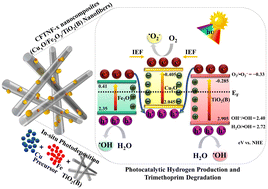Unveiling the influence of Fe2O3 nanoparticles on CuxO–TiO2(B) nanofibers for dual Z-scheme electron transfer visible light photocatalysts: investigation on local atomic structures and electronic properties†
Abstract
Although solar-driven hydrogen production and recalcitrant pollutant degradation are appealing technologies, the photocatalytic efficiency for most reactions is limited by insufficient visible-light harvesting ability and restricted charge transfer pathways. To tackle these obstacles, we designed novel photocatalyst Fe2O3/CuxO/TiO2(B) nanofibers (namely, CFTNF-y) via an in situ photodeposition strategy. The effects of the CuxO nanoparticle concentration on TiO2(B) nanofibers (CTNF-x) were investigated, and the optimized catalyst was compared to other synthesized catalysts via a chemical reduction strategy (CTNF-x (NS)). The formation of Fe2O3/CuxO nanoparticles on the TiO2(B) nanofiber (TNF) surface in CFTNF-y nanocomposites was confirmed by HAADF-STEM, elemental mapping, XRF, XPS, XANES and EXAFS results. The CFTNF-y nanocomposites demonstrated a significantly enhanced photocatalytic hydrogen production activity of 65.82 μmol g−1 h−1 under UV-visible light irradiation, which was 12-fold higher than that of pristine TNF. Moreover, the CFTNF-y nanocomposites exhibited a photocatalytic trimethoprim (TMP, a model antibiotic contaminant) removal rate of 0.1 mM g−1 min−1. These excellent photocatalytic performances can be attributed to the uniform distribution of size-controlled Fe2O3/CuxO nanoparticles on the TNF surface, improved light-harvesting ability in the visible region and a remarkable charge carrier separation/transfer rate realized via a dual-Z-scheme heterojunction mediated by an interfacial electric field. This assertion is supported by morphology analysis, ERDT/CBB by RDB-PAS, radical trapping experiments, and photoelectrochemical studies. Moreover, a plausible TMP photodegradation pathway over CFTNF-y nanocomposites is proposed based on LC-MS/MS analysis. The present work highlights a novel approach for the development of a dual-Z-scheme photocatalyst with interfacial charge transfer for achieving efficient photocatalytic performance.

- This article is part of the themed collections: Environmental Science: Nano Recent HOT Articles and Environmental Remediation


 Please wait while we load your content...
Please wait while we load your content...